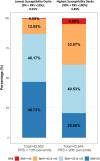Genome-wide association study provides novel insight into the genetic architecture of severe obesity
- PMID: 40939575
- PMCID: PMC12443252
- DOI: 10.1371/journal.pgen.1011842
Genome-wide association study provides novel insight into the genetic architecture of severe obesity
Abstract
Severe obesity (SevO) is a primary driver of cardiovascular diseases (CVD), cardiometabolic diseases (CMD) and several cancers, with a disproportionate impact on marginalized populations. SevO is an understudied global health disease, limiting knowledge about its mechanisms and impacts. In genome-wide association study (GWAS) meta-analyses of the tail end of the BMI distribution (≥95th percentile BMI) and two SevO phenotypes [Obesity Class III BMI ≥ 40 kg/m2 and Obesity Class IV BMI ≥ 50 kg/m2] in 159,359 individuals across eleven ancestrally diverse population-based studies followed by replication in 480,897 individuals across six ancestrally diverse studies, we identified and replicated three novel signals in known loci of BMI [TENM2, PLCL2, ZNF184], associated with SevO traits. We confirmed a large overlap in the genetic architecture of continuous BMI and severe obesity phenotypes, suggesting little genetic heterogeneity in common variants, between obesity subgroups. Systematic analyses combining functional mapping, polygenic risk scores (PRS), phenome wide association studies (PheWAS) and environmental risk factors further reinforce shared downstream comorbidities associated with continuous measures of BMI and the importance of known lifestyle factors in interaction with genetic predisposition to SevO. Our study expands the number of SevO signals, demonstrates a strong overlap in the genetic architecture of SevO and BMI and reveals a remarkable impact of SevO on the clinical phenome, affording new opportunities for clinical prevention and mechanistic insights.
Copyright: © 2025 Krishnan et al. This is an open access article distributed under the terms of the Creative Commons Attribution License, which permits unrestricted use, distribution, and reproduction in any medium, provided the original author and source are credited.
Conflict of interest statement
The authors have declared that no competing interests exist.
Figures






References
-
- Hales CM, Carroll MD, Fryar CD, Ogden CL. Prevalence of Obesity and Severe Obesity Among Adults: United States, 2017-2018. NCHS Data Brief, 1-8. 2020. - PubMed
Publication types
MeSH terms
Grants and funding
- RC4 AG039029/AG/NIA NIH HHS/United States
- I01 BX004821/BX/BLRD VA/United States
- U01 AG009740/AG/NIA NIH HHS/United States
- R01 HL163262/HL/NHLBI NIH HHS/United States
- R01 HL087660/HL/NHLBI NIH HHS/United States
- R01 DK107786/DK/NIDDK NIH HHS/United States
- R01 DK075787/DK/NIDDK NIH HHS/United States
- R01 HL119443/HL/NHLBI NIH HHS/United States
- U01 HG004729/HG/NHGRI NIH HHS/United States
- KL2 TR002490/TR/NCATS NIH HHS/United States
- R01 DK124097/DK/NIDDK NIH HHS/United States
- I01 BX005831/BX/BLRD VA/United States
- R01 DK122503/DK/NIDDK NIH HHS/United States
- R01 HL143885/HL/NHLBI NIH HHS/United States
- U01 CA288325/CA/NCI NIH HHS/United States
- R01 HL142302/HL/NHLBI NIH HHS/United States
- R01 DK110113/DK/NIDDK NIH HHS/United States
- R01 HL151152/HL/NHLBI NIH HHS/United States
- U01 HL054457/HL/NHLBI NIH HHS/United States
- R01 EY036258/EY/NEI NIH HHS/United States
- RC2 AG036495/AG/NIA NIH HHS/United States
- R01 HD057194/HD/NICHD NIH HHS/United States
- R01 DK137968/DK/NIDDK NIH HHS/United States
- R01 HL087641/HL/NHLBI NIH HHS/United States
- R01 HG010297/HG/NHGRI NIH HHS/United States
- U01 CA164973/CA/NCI NIH HHS/United States
LinkOut - more resources
Full Text Sources

